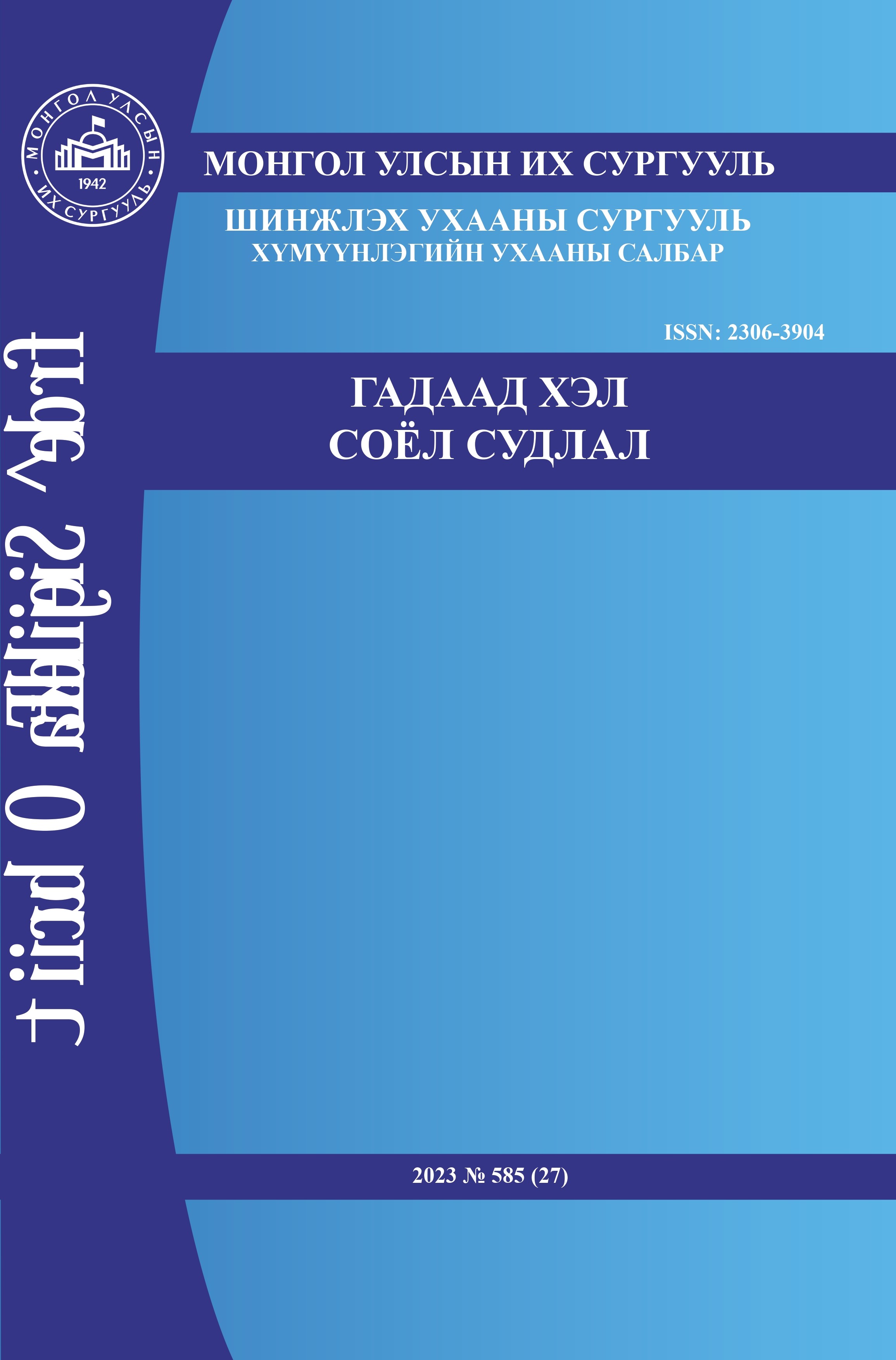Хэлний хүйсийн айн асуудалд олон хэлний хэв шинж судлалын үүднээс хандах нь
Language Gender Issues from the View Linguistic Typology
DOI:
https://doi.org/10.22353/MJFLC2023112Keywords:
хэл зүйн хүйсийн ай, үгийн сангийн аргаар илрэх хүйс, хамаатуулах хүйс, ерөнхий эр хүйс, нийгмийн үүргийн хүйс, үг бүтэхүй, зохицол, зэрэгцэлAbstract
This article will consider gender across world languages. The research will be focused on previous cross-linguistic researches on gender, theoretical backround of gender, marking of gender in languages, gender classes and some issues of world language genders. Theoretical part includes gender classes, grammatical, lexical, referential genders, generic masculine, social gender, word derivation, gender agreement, pronominalization, coordination and gender related messages. Language examples of the Sino-Tibetan, Indo-European, Finno-Ugric, Dravidian, Austro-Asiatic and Altaic language families were discussed in the article. At the end of the article grammatical, lexical, social and cognitive genders and speech of man and woman in modern Mongolian are considered in the framework of gender related issues.
References
Англи хэлээр
Bußmann, H. (2003). Engendering female visibility in German. In H. B. Marlis Hellinger (Ed.), Gender across languages (Vol. 3). Amsterdam/Philadelphia: John Benjamins Publishing Company.
Campbell, G. L. (1995). Concise compendium of the world’s languages. Routledge.
Čmejrková, S. (2003). Communicating gender in Czech. In Gender across languages (Vol. 3). Amsterdam/Philadelphia: John Benjamins Publishing Company.
Corbett, G. (1991). Gender. Cambridge University press.
Corbett, G. (2014). Gender typology. In Expression of Gender. De Gruyter Mouton.
Corbett, G. (2013). Systems of Gender Assignment. Retrieved from The World Atlas of Language Structures Online.
Dixon, R. M. (1982). Where have all the adjectives gone? And other essays in semantics and syntax. Berlin: Mouton.
Ettner, C. (2002). In Chinese, men and women are equal – or – women and men are equal? In Gender across languages (Vol. 2). Amsterdam/Philadelphia: John Benjamins Publishing Company.
Gianna Marcato, E.-M. T. (2002). Gender and female visibility in Italian. In H. B. Marlis Hellinger (Ed.), Gender across languages (Vol. 2). Amsterdam/Philadelphia: John Benjamins Publishing Company.
Hall, K. (2002). “Unnatural” gender in Hindi. In H. B. Marlis Hellinger (Ed.), Gender across languages (Vol. 2). Amsterdam/Philadelphia: John Benjamins Publishing Company.
Hellinger M, H. B. (2001). The linguistic representation of women and men. In H. B. Marlis Hellinger (Ed.), Gender across languages (Vol. 1). Amsterdam/Philadelphia: John Benjamins Publishing Company.
Hentschel, E. (2003). The expression of gender in Serbian. In Gender across languages (Vol. 3, pp. 289-290). Amsterdam/Philadelphia: John Benjamins Publishing Company.
Holvoet, A. (2011). The Baltic languages. In J. v. Bernd Kortmann (Ed.), The languages and linguistics of Europe (Vol. 1). De Gruyter Mouton.
Janhunen, J. A. (2010). Mongolian. John Benjamins Publishing Company.
Kirsten Gomard, M. K. (2003). Danish: Equal before the law-inequal in language. In H. B. Marlis Hellinger (Ed.), Gender across languages (Vol. 3). Amsterdam/Philadelphia: John Benjamins Publishing Company.
Koniuszaniec, G. (2003). Language and gender in Polish. In H. B. Marlis Hellinger (Ed.),
Gender across languages (Vol. 3). John Benjamins Publishing Company.
Marlis Hellinger, H. B. (2001). Gender across languages: The linguistic representation of women and men. In Gender across languages (Vol. 1). Amsterdam/Philadelphia: John Benjamins Publishing Company.
Pereltsvaig, A. (2012). Languages of the world an introduction. Cambridge University Press. Ronan, P. (2011). The Celtic languages. In J. v. Bernd Kortmann (Ed.), The languages and linguistics of Europe; A comprehensive guide (p. 37). De Gruyter Mouton.
Schafroth, E. (2003). Gender in French Structural properties, incongruences and asymmetries. In H. B. Marlis Hellinger (Ed.), Gender across languages (Vol. 3, p. 90). Amsterdam/Philadelphia: John Benjamins Publishing Company.
Siewierska, A. (2013). Gender Distinctions in Independent Personal Pronouns. Retrieved from The World Atlas of Language Structures Online: https://wals.info/feature/44A#2/18.0/148.9
Монгол хэлээр
Бадамдорж, Д. (2018). Танин мэдэхүйн утгазүйн удиртгал. УБ, Будапешт. Баянсан, Ж. (2016). Соёл, хэл, үндэстний сэтгэлгээ. УБ.
Мөнх, Н. (2017). Монголын нууц товчоон дахь эмэгтэй хүний нэрийн франц орчуулга. (Ф. Энрикез-Борла, Ed.) Оюуны хэлхээ, XVI, 209-219.
Нандинбилиг, Г. Д.-А. (2020). Монгол соёл иргэншил судлал. УБ. Өнөрбаян, Ц. (1998). Орчин цагийн монгол хэлний үгзүй . УБ. Поппе, Н. (2012). Монгол хэлний бичгийн хэлний зүй. УБ.
Цэвэл, Я. (1966). Монгол хэлний товч тайлбар толь. УБ.
Шагдарсүрэн, Ц. болон бусад (2022). Монгол хэл судлал. УБ.





